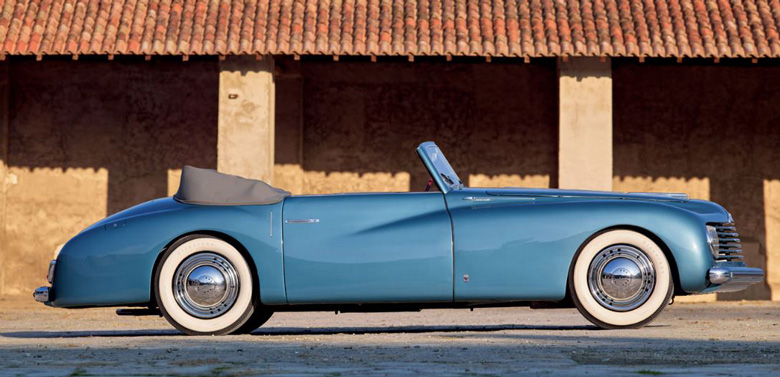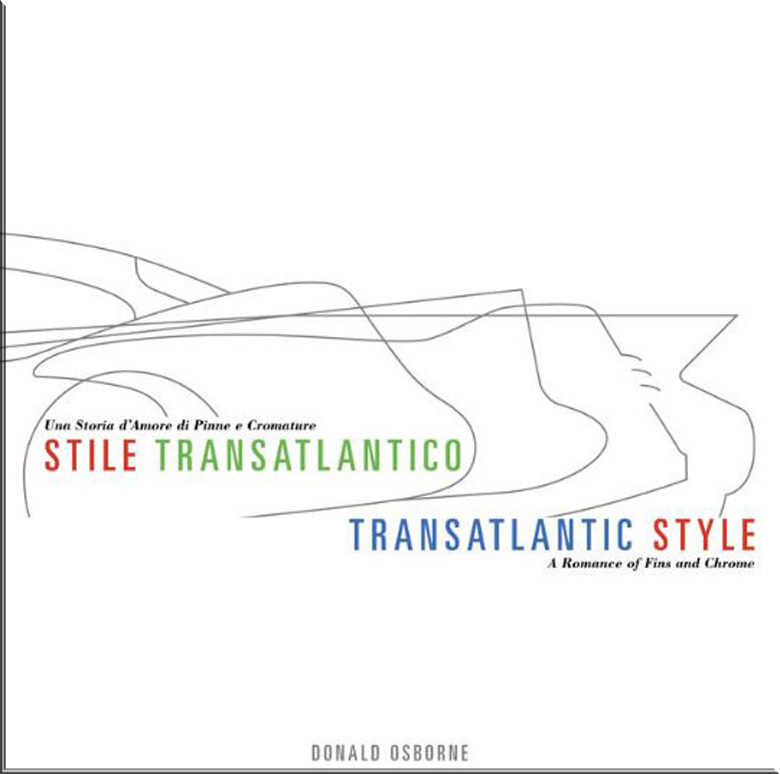Review by Pete Vack
This year, the Blackhawk Museum in Danville California, along with the Museo Dell’Automobile di Torino, collaborated on a presentation of postwar classic automobiles that depict the crossroads of American and Italian design in the 1950s and 60s.
Correspondent Brandes Elitch has previously written about the exhibit at the Museo Dell’ Automobile di Torino (read review), which ran until June 25th. Now, it is Blackhawk’s turn to look at the fascinating subject of Italian and American automotive design in the postwar period. The Blackhawk’s exhibit is “A Romance of Fins and Chrome,” or subtitled, “Jet-age Cars that Forever Changed Modern Automotive Design.” It opened on June 8 and will run through September 30. Anyone going to the Monterey Car week is well advised to attend this fantastic display of Italian, and American cars.
Stile Transatlantico / Transatlantic Style: A Romance of Fins and Chrome is also the accompanying English/Italian coffee table book, written by Donald Osborne, with contributions from serious collectors Don Williams and Corrado Lopresto. Osborne’s book was published in 2016 before the opening of the exhibitions and formed the basis for both.
We applaud and endorse such exhibitions
We are very pleased to note that both the prestigious Museo Dell’Automobile di Torino and the Blackhawk have taken an interest in presenting this subject. Osborne’s book is the first to address this, and he does so very well.
VeloceToday has previously just scratched the surface of this subject with our series on the work of Giovanni Savonuzzi and Michelotti. The cross-pollination of automotive design is fascinating, particularly when placed in a social milieu that also provides rich contrasts. Nowhere is this more obvious or fruitful than Italy and North America. And why not – Italy and the U.S. were the only major players in postwar automotive design. Furthermore, it occurs at the apex of the development of the automobile as well as the European economic miracle, the years from 1945 to 1965.
“My goal in creating this Transatlantic Style project is to reveal to a larger world the remarkable work of brilliant designers from this fertile period and how much it was shaped by this cross-cultural exchange,” says Osborne. “Our culture and values today are the result of our pasts and perhaps with a greater understanding we can see what truly open minds in full creative flower can achieve.”
Focusing on the details
If this seems a bit ambiguous, it may be because the subject has a great deal of depth. Osborne did not dwell on the socio-cultural differences of the two counties, but touched on it lightly, which is probably a good thing, for as the CrossRoads Exhibition may have found, it is easy to get lost in the pop cultural images and icons, flitting back and forth between Hollywood and Rome, wondering about the real meaning of fins and chrome, and trying to paste it all together into some cohesive historical perspective concerning car design. As interesting as that aspect is, it often detracts rather than adds to the subject.
Since so many find it hard to concentrate these days, fortunately both the book and the Blackhawk exhibition chose to focus on design. To get his point across, Osborne was able to focus in a two-minute video on the Blackhawk site (and in the book). He clearly explained what the exhibit was trying to do, and provided excellent visual examples of how design motifs went from Italy to American designers and vice versa by comparing the rear quarter vents and sculpted sides of the Ghia 1900 Alfa next to the 1965 Mustang GT fastback. Another striking example was demonstrated in the book by Don Williams; look at the rear view of a 1963 Corvette Stingray coupe at the B.A.T. 9. They are minor points, but ones that get attention and understanding from a wider audience. And that, of course, is what this is all about. (See the video)
(Read about the 1900 Ghia in VeloceToday)
Schools or Tools?
Overall, we found the book to be excellent, and the assertions both interesting and compelling. However, Osborne defines two ‘schools’ of design developing in the post war Italian era of car design, the Cisitalia school and the more flamboyant American-inspired designs typical of Michelotti and Mario Revelli. Visually, this seems to be the case. But the term ‘school’ implies that there were divergent and separate design dogmas. Perhaps it is more realistic to say that in the post war period, Italian designers had more tools to work with and did so with great talent. Most, like Pinin Farina, worked with both ‘schools’ at the same time, capable of producing the Lancia B20 and the Lancia Aurelia PF 200 at roughly the same time. Michelotti created some of the most beautiful and clean Ferrari coupes without a hint of overt chrome. It worked the other way too, but not as often or as successfully; one might visualize the relatively clean 1955 Chevy with a distinctly Ferrari-like egg-crate grille. (We can’t help but think of how quickly the almost Italianesque ’55 Chev was bedecked with fins and chrome and bullets. So much for Italian influence in the long term.)
Cars on Exhibit
One might gain a better perspective if attention is focused the automobiles selected for the exhibition. These cars are also subjects in the Osborne book. And they are:
-Buick Y-Job
-Le Sabre
-Cisitalia 202 MM Aerodinamica
-Cisitalia 202 SC Coupe
-Lancia Aurelia B20 Coupe
-Alfa Romeo Giulietta Sprint
-Nash-Healey Roadster
-Plymouth Belmont
-Chrysler GS-1 Coupe
-Alfa Romeo 1900 CSS Ghia Coupe
-Hudson Italia
-Lancia Aurelia B24 Spider America
-Ghia Streamline X ‘Gilda’
-Chrysler 300F Convertible
-Lancia Flaminia Pinin Farina Coupe
-Maserati 5000GT Touring Coupe
-Cadillac Eldorado Brougham Pinin Farina
Back to the books
Since Osborne’s book is the only one so far to broach this subject, it is important. He does a very complete job, beginning with ‘Birth of a Style’, a discussion of the move toward streamlining and aerodynamics in the 1930s (and using the Buick Y Job to illustrate what was happening in the US). This is followed by ‘A Romance is Born,’ and it encompasses the flowering of design in post war Italy to about 1954, with tributes to the Buick Roadmaster and Le Sabre on the American side. Moving on to ‘Cultures Merge,’ the book describes the work of Virgil Exner at Ghia, the Pinin Farina Nash years, and the Hudson Italia. Then he defines the styles in the mid-50s with ‘Mid-Atlantic, Mid-Decade’ as exemplified by the famous finned Ferraris and Alfa B.A.T.s. Lastly, ‘Italian Style Triumphant’ is typified by the Lancia Flaminia Pinin Farina Coupe, the Maserati 5000 GT, and the Alfa Romeo 2000 “Praho” from 1960.

Furman’s portrait of the Alfa 6C 2500. Design attributed to Giovanni Michelotti, Mario Revelli di Beaumont and Stablimenti Farina.
Osborne’s text, which is well written and interesting, often gets lost in the pages. One’s attention is stolen by the magnificent photography of Michael Furman, whose Coachbuilt Press also published the work. There are also contributions of cars and book chapters from collector Don Williams and Italy’s Corrado Lopresto (who provides a very interesting and welcome chapter on Mario Revelli).
Don’t expect this to be a definitive, well documented work; in a sense that would defeat the purpose here. That book remains to be written and should be a much deeper, scholarly effort. There is no index, a short bibliography for further reading and no footnotes.
Opinion? If you can get to the Blackhawk, be sure to do so before the exhibit closes. Osborne’s book, while not perfect, should be on the bookshelf of any serious student of Italian, or American automobile design. The basic price of $100 is very reasonable for such a high quality hardbound book.
Stile Transatlantico / Transatlantic Style: A Romance of Fins and Chrome, is available for purchase through its publisher at CoachbuiltPress.com, on Amazon.com and leading automotive booksellers around the world. It is written in both English and Italian. The standard book price is $100 and, for $450, one of 50 numbered special editions may be purchased, offering a unique hardbound cover, plastic slipcase and tip-in page with the signatures of author Donald Osborne and photographer Michael Furman. To look inside and purchase online click here.
Associated with the Smithsonian Institution, the Blackhawk Museum is open year round on Wednesday through Sunday and is located 30 miles east of San Francisco in Blackhawk Plaza at 3700 Blackhawk Plaza Circle, Danville, CA 94506. For more information, please visit BlackhawkMuseum.org
If you liked this article, click here to subscribe to VeloceToday!

I, too, would love to read a “much deeper, scholarly effort” on the subject. But I suspect that book won’t be perfect, either. In fact, I suspect it can’t be done in a single book. I daresay it (they?) will be a far less beautiful book than the one that Donald and Michael have created. And beauty has real purpose here. This is a subject that is illuminated by magnificent photographs in which one can grasp real detail, and essays that are no less well-thought for their lack of footnotes. Beyond that, I’d suggest that beautiful books on hitherto-unexamined subjects tend to highlight those subjects as worthwhile objects of scholarly study. Let’s hope this one does that.